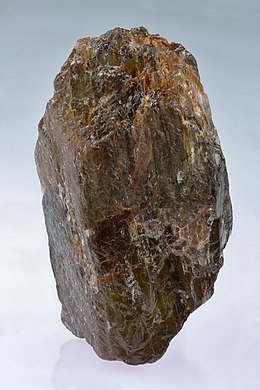| Andalusite | |
|---|---|
 Andalusite | |
| General | |
| Category | Nesosilicates |
| Formula (repeating unit) | Al2SiO5 |
| IMA symbol | And |
| Strunz classification | 9.AF.10 |
| Crystal system | Orthorhombic |
| Crystal class | Dipyramidal (mmm) H-M symbol: (2/m 2/m 2/m) |
| Space group | Pnnm |
| Unit cell | a = 7.7980 Å, b = 7.9031 Å c = 5.5566 Å; Z = 4 |
| Identification | |
| Color | Pink, violet, yellow, green, white, gray; in thin section, colorless to pink or green |
| Crystal habit | As euhedral crystals or columnar aggregates having nearly square cross sections; fibrous compact to massive |
| Twinning | On {101}, rare |
| Cleavage | Good on {110}, poor on {100} |
| Fracture | uneven to subconchoidal |
| Mohs scale hardness | 6.5–7.5 |
| Luster | Vitreous |
| Streak | White |
| Diaphaneity | Transparent to nearly opaque with inclusions |
| Specific gravity | 3.17 (± .04) |
| Optical properties | double refractive, biaxial negative; chiastolite has anomalous aggregate reaction.[1] |
| Refractive index | nα = 1.629 – 1.640 nβ = 1.633 – 1.644 nγ = 1.638 – 1.650 |
| Birefringence | δ = 0.009 – 0.010 |
| Pleochroism | strongly trichroic |
| 2V angle | 71–86° |
| Dispersion | r < v strong |
| Ultraviolet fluorescence | non-fluorescent |
| References | [1][2] |
Andalusite is an aluminium nesosilicate mineral with the chemical formula Al2SiO5. This mineral was called andalousite by Delamétherie,[3] who thought it came from Andalusia, Spain. It soon became clear that it was a locality error, and that the specimens studied were actually from El Cardoso de la Sierra, in the Spanish province of Guadalajara, not Andalusia.[4]
Andalusite is trimorphic with kyanite and sillimanite, being the lower pressure mid temperature polymorph. At higher temperatures and pressures, andalusite may convert to sillimanite. Thus, as with its other polymorphs, andalusite is an aluminosilicate index mineral, providing clues to depth and pressures involved in producing the host rock.[5]

- ^ a b Gemological Institute of America, GIA Gem Reference Guide 1995, ISBN 0-87311-019-6
- ^ http://rruff.geo.arizona.edu/doclib/hom/andalusite.pdf Handbook of Mineralogy
- ^ Delamétherie, Jean Claude (1798). "Sur une pierre de l'Andalousie". Journal de Physique, de Chimie d'Histoire Naturelle et des Arts. 46: 386–387.
- ^ Calvo, Miguel (2018). Minerales y Minas de España. Vol. IX. Silicatos. Madrid, Spain: Escuela Técnica Superior de Ingenieros de Minas de Madrid. Fundación Gómez Pardo. pp. 91–94. ISBN 978-84-8321-883-9.
- ^ Whitney, D.L. (2002). "Coexisting andalusite, kyanite, and sillimanite: Sequential formation of three Al2SiO5 polymorphs during progressive metamorphism near the triple point, Sivrihisar, Turkey". American Mineralogist. 87 (4): 405–416. Bibcode:2002AmMin..87..405W. doi:10.2138/am-2002-0404. S2CID 131616262.
- ^ Whitney, D.L. (2002). "Coexisting andalusite, kyanite, and sillimanite: Sequential formation of three Al2SiO5 polymorphs during progressive metamorphism near the triple point, Sivrihisar, Turkey". American Mineralogist. 87 (4): 405–416. doi:10.2138/am-2002-0404.
